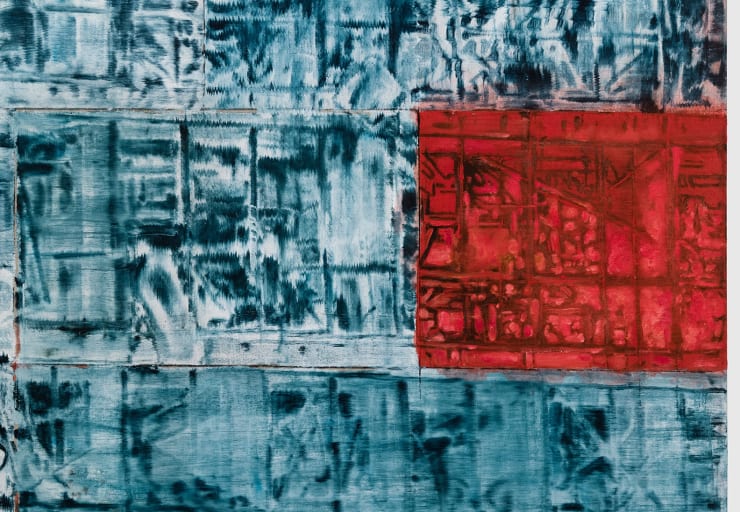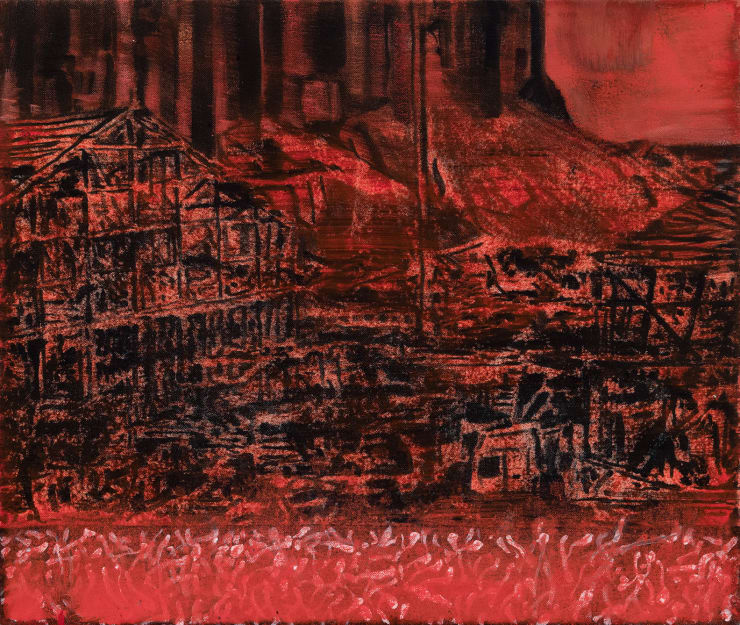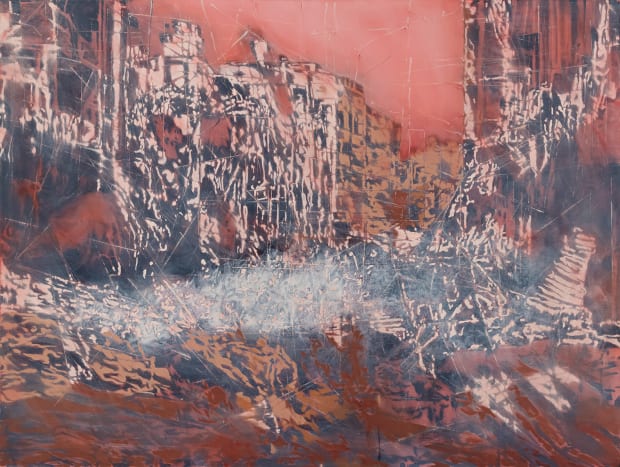-

-
On a summer day in August 2020, a massive blast rocked the city of Beirut. Ammonium nitrtate, improperly stored at Beirut's port, exploded in a mushroom of flames and smoke, resulting in at least 215 deaths, 7,500 injuries, and approximately 300,000 displaced people. Images and videos of the disaster were captured by citizens on various devices, and shared across the globe.
To the Lebanese, the explosion was another example of the failure of their government to effectively protect its citizens and root out corruption. Protests criticizing their role in the disaster surged, bolstered by other anti-government groups in Lebanon. Today the port, a vital part of Beirut's infrastructure, awaits rebuilding.
Following the blast, Jorge Tacla created a series of paintings about Beirut, featured in this viewing room. Highlighted is Injury Report 6, shown here.
-

-
Many of Tacla's paintings are based on images either sent to him by friends or that he finds online and in newspapers. For his Beirut series, the artist also pulled photographs of the disaster circulated on social media.
Destruction, both man-made and natural, has long been a subject of interest in Tacla's work. He has previously painted scenes of the 2010 earthquake in Haiti, 1995 Oklahoma City Bombing, 9/11 terrorist attacks on the Twin Towers and the Pentagon, demolished city blocks in Syria, and more.
In the following essay, curator and critic Christian Viveros-Fauné discusses Tacla's use of devastation in his work. There is a value, he argues, in confronting catastrophe.
-
Tacla, the Destroyer
By Christian Viveros-FaunéA great artist, he has moved past the horror before the rest of us by depicting trauma so precisely.
Hamburg, September 16, 2001 - German composer Karlheinz Stockhausen is asked by a music journalist whether the characters in "Licht," his 7 day opera cycle, are for him "merely some figures out of a common cultural history" or rather "material appearances." To this the composer replies, "I pray daily to Michael, but not to Lucifer. I have renounced him. Still he is very much present, like in New York recently."
Intrigued, the journalist jots the answer down, and pushes on: "How have the events of September 11th affected you? How do you view the attack in connection with the harmony of humanity represented in your music?" Stockhausen gathers his thoughts, takes a deep breath, and unspools at unfortunate length:
"Well, what happened there is, of course-now all of you must adjust your brains-the biggest work of art there has ever been. The fact that spirits achieve with one act something that we, in music, could never dream of, that people practice ten years madly, fanatically for a concert. And then die. [Hesitantly.] That is the greatest work of art that exists for the whole cosmos. That there are people who are so concentrated on this single performance, and then five thousand people are driven to resurrection… [Now, more forcefully.] In. One. Moment. [Hesitates, this time at greater length.] I couldn't do that. Compared to that, we are nothing."
Writing poetry after Auschwitz, as Theodor W. Adorno said, is barbaric. So is painting after September 11-a crushing date, especially if one was unlucky enough to have lived through its horrors in Santiago, Chile, in 1973, and also in New York in 2001. Ditto for composing music. Or making any other type of art, for that matter.
There is nothing that can decently follow catastrophic events of such world-changing proportions. The tools normally at our disposal-the grammar of art, its ancient traditions, its durable symbols-powder away into insignificance. Instances when capitalized History shoulders in thuggishly through the locked gate, shocks like these are to human societies what the giant asteroid was to the dinosaurs: the light-switch blow that sets off what anthropologists blithely describe as "the extinction event."
Adorno was more right than he ever knew: creating anything in the shadow of epic destruction presents an unforgivable offense to the victims of carnage. But, in its own awful way, it also constitutes a horrible crime against the perpetrators. Perfection demands respect--that and an acceptable interval of pause to gain perspective.
How long? A month? A year? Twenty years? Butchers like Josef Mengele, Mohamed Atta, and Augusto Pinochet are not, it must be understood, born every day. They are the Einsteins, Mozarts, and Maradonas of death. Mere mortals puttering away in their terrible wake are left to absorb a crucial lesson recently summed up in a blasphemous newspaper cartoon. The cartoon depicts the biblical Joseph in bed with a whorish Mary. Beneath the doodle it chuckles savagely: "God was a hard act to follow."
"Compared to that, we are nothing." Yet certain naive folks abound-most call themselves artists-who take it upon themselves to interrupt the well-earned silence of Thanatos, the Greek god of death. I distinctly remember the efforts of a few such characters inside New York galleries following the attacks on the World Trade Center. One displayed a garishly realist portrait of then-President George Bush, painted to look like an anemic porgy. Another featured live video feed from the wound inside the ground in downtown Manhattan-an ex-piece of real estate that came to acquire the unlucky sobriquet "Ground Zero," in dark honor of the Manhattan Project. Still, neither these two fellows nor any other artist I know-excepting possibly Julian LaVerdiere and Paul Myoda, the designers of "Tribute in Light," the illuminated columns that intermittently memorialize the lost skyline of New York-have gone so far as to commit the repeated crimes of painter Jorge Tacla.
*Now I am become Death, the destroyer of worlds.
J. Robert Oppenheimer
Jorge Tacla is barbaric. He is a terrorist of art. A painter who has spent years engaged in a literal battle to the death with the withering reality of memory, he creates ashily colored remembrances of collapsing buildings, frightening gaseous implosions, and ruined civilizations. His subject is historical annihilation, but-mind you-he is not merely concerned with its vaunted nugatory powers. Tacla's greatest single offense-and he has many-is his celebration of the sublime. An idea so dangerous it is capable of alchemically sluicing the bad into the good, it provides the extra-added terror for this upstart figure to pitch gasoline into disaster's roaring emptiness-its horror vacui.
Tacla has had help-you might call them accomplices. Among the rogue's gallery of historical abettors on whom the offending painter is reliant, several will appear familiar. Some are mild-mannered writers. Others could accurately be described as bookish intellectuals. A third and larger group are made up chiefly of dispassionate-seeming artists, most of them painters. As with Hitler's cabinet, Pinochet's dark-suited torturers, and Al Qaeda's televisionary jihadists, real-life and symbolic death always sport the same inspired faces.
Consider for a moment Edmund Burke's role in the commission of Tacla's crimes. Like a latter-day Sayyid Qutb-the once forgotten author who in death became radical Islam's most influential theorist-Burke's philosophical incantations have proved invaluable to Tacla's repeated production of terrible beauty. Burke was, in fact, the first to describe the devil's pact struck between the sublime and the beautiful in his treatise A Philosophical Enquiry into the Origin of Our Ideas of the Sublime and the Beautiful. Of this freakish marriage he wrote: beauty may be accentuated by light, but either intense light or darkness-by which he meant simply the absence of light-becomes sublime when it obliterates the sight of an object. Burke further argued, contra natura, that the imagination is capable of being moved by things that are "dark, uncertain, confused." Going where Aristotle and Augustine feared to tread-both preferred to avert their eyes from the ugly-Burke opened wide Hell's gate to a special type of esthetic fanaticism. The damage done to art has become since, in a word, indescribable.
From Burke's time until today, the notion that horror can induce pleasure has compelled battalions of artist-terrorists towards investigations of the sublime. To take a few prominent examples, there have been extremist works like these: there's Théodore Géricault's cannibalizing castaways in his Raft of the Medusa; J.M.W. Turner's pitiless renderings of the House of Parliament burning; Caspar David Friedrich's landscapes, which he himself described as "stark and dead;" Pablo Picasso's savage response to the first reports of Nazi death camps in The Charnel House; and Gerhard Richter's Baader-Meinhof cycle, a cruel suite of fifteen canvases that feature, all too fittingly, the first images of terrorists the world saw through the medium of television. These paintings and other artworks have served as templates for what one interpreter has called Jorge Tacla's "negative vision of history." That vision-as recorded in past art and certainly in Tacla's merciless canvases-holds us in its thrall, like a smoking, mangled wreck that holds no chance of survivors.
Before committing himself to his present day provocations, Jorge Tacla had already embarked on the unnatural path of addressing destruction and its long, grisly history. His earliest paintings featured naked, isolated figures. Serial versions of an everyman, his blustering anthropoids engaged in stark pantomimes of primitive human behavior. Existential beings that recall both Sartre's remark that "hell is other people" as well as Francis Bacon's struggling simian imagery, these figures animated the artist's first washed-out landscapes- semantic junkyards that accumulated random-seeming notations. In his titles, Tacla called these places by their formal names: "topologies," "spaces for discourse," and "places in common." Their shared language, though, remains the lingua franca of pain.
In time, Tacla's forests of marks coalesced into illusionistic landscapes. He rescued these canvases from the usual conventions by literally painting them in reverse-emphasizing the outlines so that their chalky scaffoldings might be obliterated by their monochrome backgrounds. What Tacla chose to paint-from all the possible subjects in the world-was nothing less than pictorial and metaphysical instability. He filled his dun colored wastelands with figures, trees, architectures, and even "windows"-of the sort that anticipated computer graphics. The fact that he did so in the negative, like photographic film, set the stage for what amounts to a ruthless inversion of values.
"The canvas has been prepared where it is not painted," Tacla declared defiantly. He formulated another idea with even greater force: "The objects and landscapes are transparent and are the negatives of their physical condition." Up was down, and down was up-the natural order of things teetered in the balance. The stage was set then for Tacla to actively disavow beauty in order to paint implacably sublime representations of world catastrophe.
*
History is a nightmare from which I am trying to awake.
James Joyce
Jorge Tacla was a witness to the events of September 11, 1973 in Santiago, and so was I. That gray day American-made Hawker-Hunter jets strafed and bombed La Moneda, Chile's presidential palace. After an intense gun battle, Salvador Allende-Chile's President and the world's first democratically elected Socialist-took his life, aborting a political and social experiment on which millions had pinned their hopes. I heard these now familiar words then: "It was like a movie." That was the first time I took particular note of that phrase, which later became the stock response to the terror visited on Manhattan in 2001. Tacla was also in New York then, painting away; I was there, too-we were two tiny specks among the broad canvas of New York's eight million souls. On both dates, the movie turned out to be very, very real.
Drawing inspiration decades later from his memory of the events in Santiago, Tacla painted several versions of La Moneda in flames. Turneresque in their near abstraction, these canvases described serial conflagrations that lean far more toward the hallucinatory than the realistic. Tacla titled these paintings with a vengeance. One purplish number he called Medium Rare (1995); Gas Machine (1996) another. A third painting, Nitrogen Cycle (1996)-a smudged view of the same lacerated structure violated by a grid of light and shade-extended Chile's misery through Tacla's trademark windows. Tacla guessed rightly that Chile's pain would be redistributed into zones of unknown geographical contingency through exile and what one might call "historical karma." It was as if Oswald Spengler had risen and someone had given him a brush.
Tacla's variegated views of a shattered, luminous La Moneda became, in his words, "not the depiction of one place," but a representation of what he termed "the place of painting." By this Tacla meant a metaphysical arena-located somewhere between the studio and the scene of the crime-where both the real horror and the idea of mass destruction could be symbolically reconstructed. A visual echo of a spiritual revelation, Tacla's canvases sound the same yielding note struck by J. Robert Oppenheimer's famous borrowing from the Bhagavad Gita. "If the radiance of a thousand suns were to burst at once into the sky," the father of the H-bomb warbled as he watched the first mushroom cloud blaze over the New Mexico desert, "that would be like the splendor of the mighty one." Unsurprisingly, both Oppenheimer's citation and Tacla's smoldering works also recall the last words of Joseph Mallord William Turner: "The sun is God."
From the hellfire of his serial depictions of La Moneda, Tacla moved onto confecting pictures of more recent bone-splintering, soul-sucking disasters: the city of Granada after the devastation visited it on it by Colombia's FARC, the bombed-out Alfred P. Murrah Federal Building in Oklahoma City, buildings obliterated in Beirut, Lebanon, after yet another exchange of rocket fire between Israel and Hezbollah. Suffused with radiant light and saturated color that suggest both faded newsprint and desert fields at dusk, Tacla's renditions of these events take on the grandeur of Albert Bierstadt's famous transcendentalist painting Sunrise on the Matterhorn. Oblivion has rarely looked so awe-inspiring.
What Jorge Tacla has consistently learned to marshal in his canvases is the "shock and awe" of painting. Impelled by destruction of a largely militarized sort-recent series, in fact, sport titles like Trauma, Rubble, and Camouflage-his pictures often advance on our knowledge of catastrophe, and at least once, even on our intelligence. This is the case with a work Tacla made about the destruction of the World Trade Center. Incredibly, it is possible to claim that the artist "anticipated" the 9/11 commercial airliner attacks on the Twin Towers in a painting he made in the year 2000. Titled Meat Carrier, Tacla's canvas eerily depicts the cockpit of a 767 from the vantage point of a standing, looming figure. Bathed in electric blue light, the image represents historical events in a way no one except the actual perpetrators could have imagined.
This leads us directly to Tacla's paintings based on the 9/11 attacks, whose effects are as arresting as they are plainly devastating. There are, among a raft of stirring works, the pictures Breaking Point 1 and Breaking Point 2-intensely colored and schematized canvases that display compositions in which, to take a line from W.B. Yeats, "things fall apart; the center cannot hold." And then there is Total Eclipse: a distorted aerial view of downtown Manhattan with what can only be described as an anamorphic blur ghosting the left hand side of the canvas. Like Holbein's skull in The Ambassadors, this volatile wraith represents the magnetic pole of an alternate reality-the perspective of death. It hovers over everything, forcing vision to radically exceed itself precisely at the spot where the missing buildings used to be.
Yet it is the canvases Mass of Vapor I and Mass of Vapor III that best illustrate the principles of Burke's conception of the sublime. Gorgeously realized, intensely realist renditions of the pulverized muck Mohamed Atta and his team of hijackers made of thousands of tons of steel and concrete as well as the meat and calcium that once constituted 2,752 human beings, these works effectively redeem the anguish of collective memory by sublimating it in pigment and canvas. These paintings at once constitute Jorge Tacla's biggest triumph and his greatest crime. A great artist, he has moved past the horror before the rest of us by depicting trauma so precisely. If you listen carefully, you can almost hear the screams.
-

-

-

-
The artist's new series of paintings about Beirut are not his first portrayals of Lebanon. In 2007, the artist painted Escombro 0 as part of his Rubble series. The painting shows the aftermath of a bombing in a crowded neighborhood, with buildings laid to waste. It was a year of much conflict in the country, and the bloody red hue of the sky echoes the lives lost in different skirmishes.
-

Beirut
Past viewing_room












